22 Small Tool Trailer Ideas
Updated: October 14, 2021
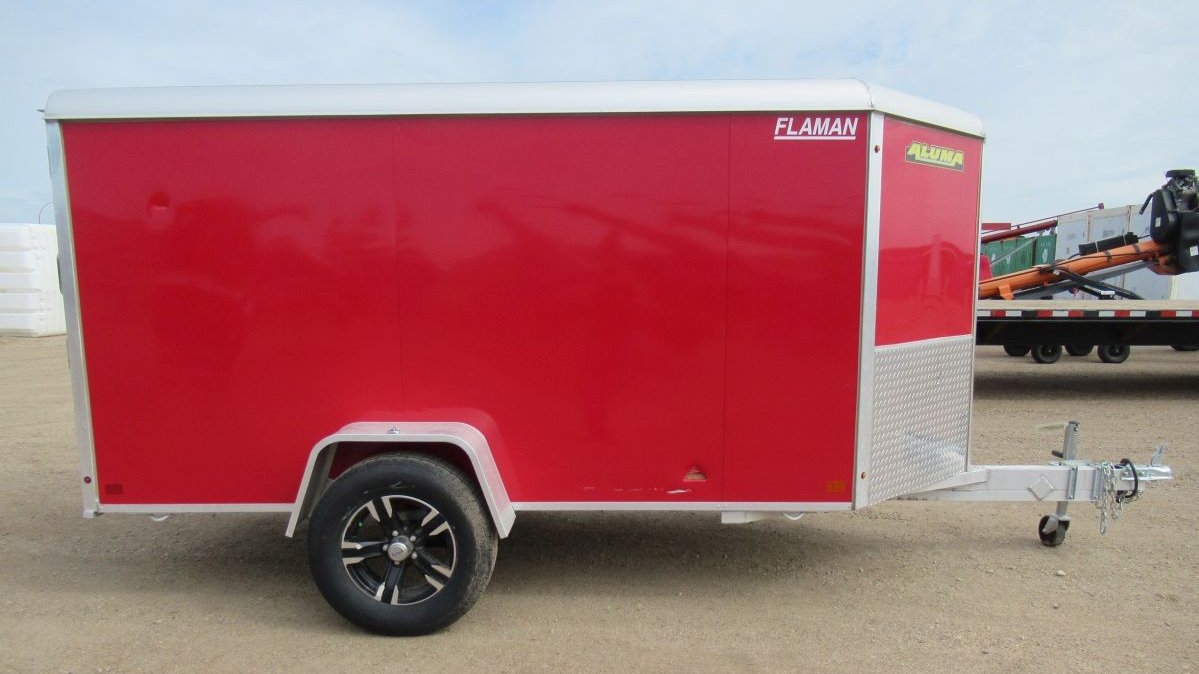
It's tough to plan your small tool trailer's layout. You want to build something efficient, but you don't know where to start.
But it's not that daunting to do this kind of build - you just need to follow some principles that will help you think about how you'll use your tool trailer.
So we're going to take a look at some small tool trailer ideas that you can use in your build to make you work faster and cleaner.
Do you have to do any of these things?
Nah....
Think of them as suggestions and inspiration. If you can figure out your workflow, you can build a great tool trailer.
What Size Tool Trailer?
We're going to talk about trailers that have an nominal width of 5 or 6 feet or less (such as a 5x10). A 5 or 6-footer is skinny enough to fit in the rear track of a full-width pickup truck but creates restraints on how you can store tools.
Why?
Narrower width means narrow shelves and a narrow center aisle.
Small Tool Trailer Layout
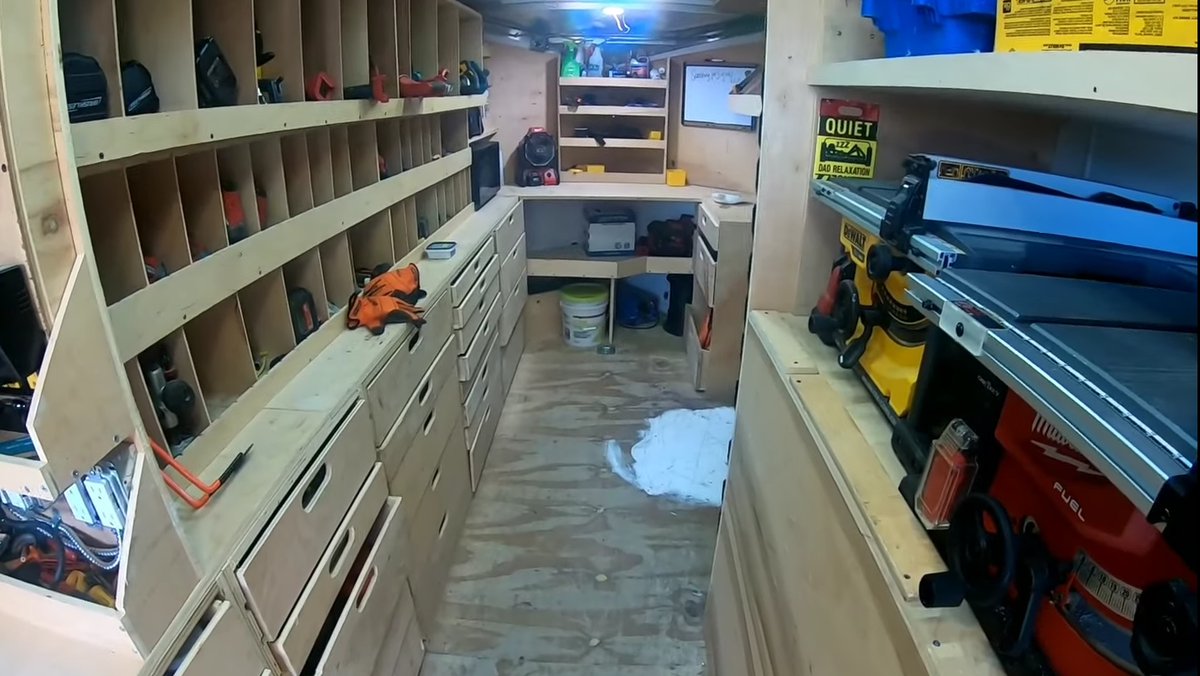
Many tool trailers have a "standard" layout of a center aisle with a row of storage on each side.
Consider that you can modify the design however you want.
Plywood storage?
Turn part of one side into a long slot.
Removable sections for cargo hauling?
Read below about E-Track and removable tool boxes.
There are lots of designs out there, so try to build in a way that lets you change your layout in the future.
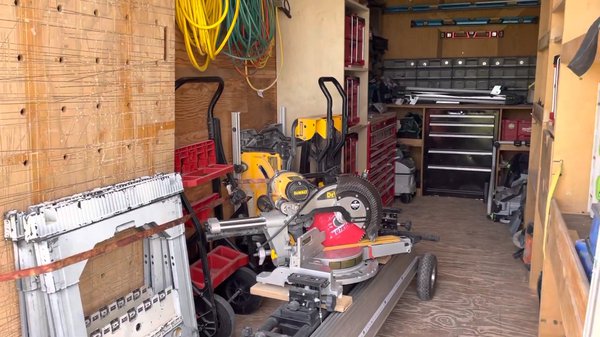
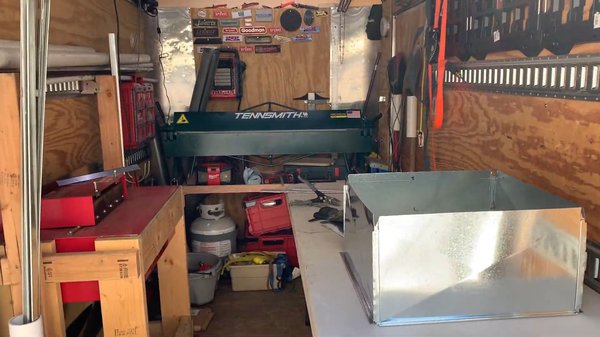
Get a Trailer You Can Stand in Without Stooping
If you're working out of this trailer and will be in and out of it multiple times a day, make sure you can stand up straight inside!
If you can't stand in your trailer, you won't want to be in it.
If you don't want to be in it, you won't keep it organized.
Archie's small carpentry trailer looks great, but it's probably painful to spend a lot of time in it.
Being able to stand is good for your body and good for your psyche.
Store Big Tools in the Back (unless they are incredibly heavy)
Miter saws, table saws, tables, stands, and saw horses should all be at the back of a small tool trailer.
The aisle of a small tool trailer is narrow, and extracting, wheeling, and/or manhandling a large tool to the outside can add time and exertion to the start and end of your day.
Some tools with built-in wheels might be too wide to be wheeled through your aisle.

Put Super Heavy Stuff Close to the Wheels
Some tools are very heavy, like drain cleaning machines. Some plumbers carry three of these monsters! Heavy tools like this should be carried nearer to the front of the trailer or over the wheels.
Why?
Too much weight on the rear of your trailer can cause it to fishtail dangerously while you're driving. If you're using a small tool trailer, you may be pulling it with a small truck, and this effect will be amplified with a smaller tow vehicle.
Build a Fold-Down Table on the Outside
Small tool trailers will often lack flat surfaces that you need as temporary spaces.
Mount a flip-down table on the outside of your trailer near either or both of your doors and you'll have a quick-deploy work area.
This is also a great tip for big tool trailers!
A cutting board or piece of painted 3/4" plywood will do the job.
An extreme example of this is Neal's aluminum renovation tool trailer. He makes use of fold-down tables and tool pull-out. His entire trailer is a mobile workshop!
Build a Pull-Out Table on the Inside

If you maximize storage inside and have no workbench, you can still sneak one in by building a slide-out work area with drawer-slides.
Mount it between shelves or drawers.
Pull it out when you need to look through a screw organizer.
Carry a Canopy or Umbrella

If you have a small tool trailer, you'll end up working outside a lot. Bring a canopy and you can set it up in your client's driveway with your tools underneath. This will do a good job of keeping the sun off.
In worse weather, you can close off part of the canopy with a tarp or two. This is a great solution if you're working on a HVAC unit in cold weather and you're freezing to death.
This won't work as well if you need to process long lengths of materials like pipe or wood.
Bring a Folding Table

A six foot folding table is cheap and will give you the work area you need. You can also use sawhorses and piece of plywood, but the table will be a little quicker to set up.
There are more complicated multi-function tables out there and MFTs with a zillion holes that need the special clamps.
But...
You're trying to minimize the space your tools occupy, so keep it simple.
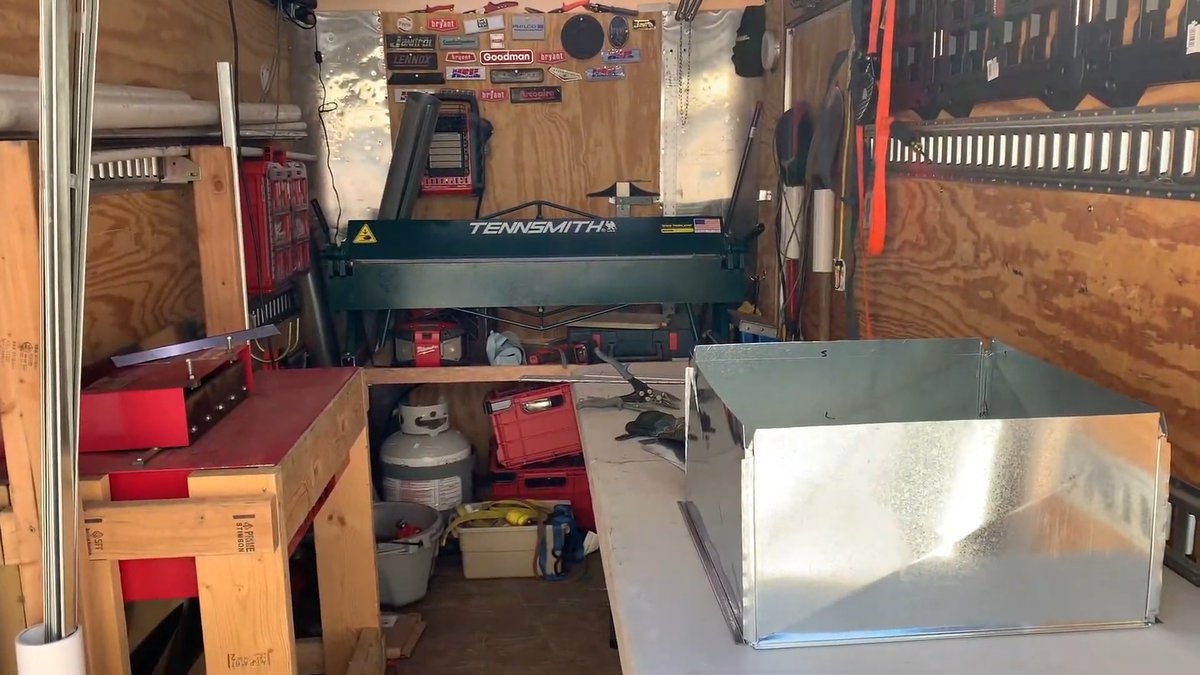
Put Your Spare Tire on the Tongue

Your spare tire should not live in your tool trailer.
It's awkwardly shaped. It's heavy.
It takes up a lot of space for something you will use infrequently.
If you touch your spare more than once a year and it isn't for a tire change, you're doing it wrong.
Get a Roof Rack

You can store material and ladders on a roof rack.
You can buy aluminum brackets that bolt on to your little tool trailer's roof that you can fit with aluminum or 2x4 cross bars.
Roof racks are nice to have, but it's likely that you'll need to use another ladder to get ladders or material off the rack.
-1 for speed, and ladders outside mean they get wet, icy, and weathered.
Or Hang Your Ladders on the Outside

You can mount your ladders on the side of your trailer above the fender.
This makes it a lot easier to get your ladders down. You won't need a ladder to get your ladder!
Side-mounting limits the length of ladder you can mount (to not much longer than the trailer body).
Side-mounting ladders can also impact your driving visibility a little. Most tool trailers have a passenger side door, which means that ladders need to go on the driver side outside wall of the trailer.
Make sure you lock 'em up! Ladders that are easy for you to access are also easy for thieves to access.
Use a Multipurpose Ladder Plus a Small Stepladder


Multipurpose ladders are short when folded and can be used as step and extension ladders.
They're small enough to store in your tool trailer which means:
- They are quick to grab.
- They aren't exposed to weather.
Couple this with a lightweight, door-mounted, flat two-step step ladder, and you have a pretty good combination.
If it really irks you not to have a 6-footer, slap a six foot step ladder on your ceiling with some hooks or a Jet-Rack.
Specialize in Your Trade

Why are you doing everything?!
If you're a carpenter, you could do cabinets and framing and decks and maybe a little tile and plumbing and electrical.
Or you could just stick to cabinets.
If you're a plumber and HVAC-R tech, you could do plumbing, HVAC, refrigeration, residential, commercial, and industrial.
Or you could just stick to heating.
You can often choose to focus on residential, commercial, or industrial instead of all three.
This tip is related to your goals:
Do you want to build an empire, or do you just want to earn a decent living?
The more types of work you do, the more tools and inventory you need. You need a larger tool trailer and a larger truck to pull that trailer.
If you specialize, you can still make money and build your reputation.
Get Materials Delivered
Having materials delivered takes a lot of responsibility off your plate.
You save time since you don't need to drive to a supply house, load up, and drive back to the job.
You might be on the edge about this:
- You may save some on fuel.
- You might need to pick some other materials up that you want to see.
- This could be borderline on saving cash, but it depends on you how value your time and how long self-delivering takes you.
Some tradespeople go all-in on material delivery and will have HVAC equipment, building materials, water heaters, or cabinetry delivered to the job site.
Need inspiration?
Here's a home remodeler who works out of a Ford Transit Connect!
He has materials delivered by suppliers.
Look at Van Organization
There are plenty of work vans out there that have excellent organization in a space the size of a small tool trailer.
Use Less Plywood
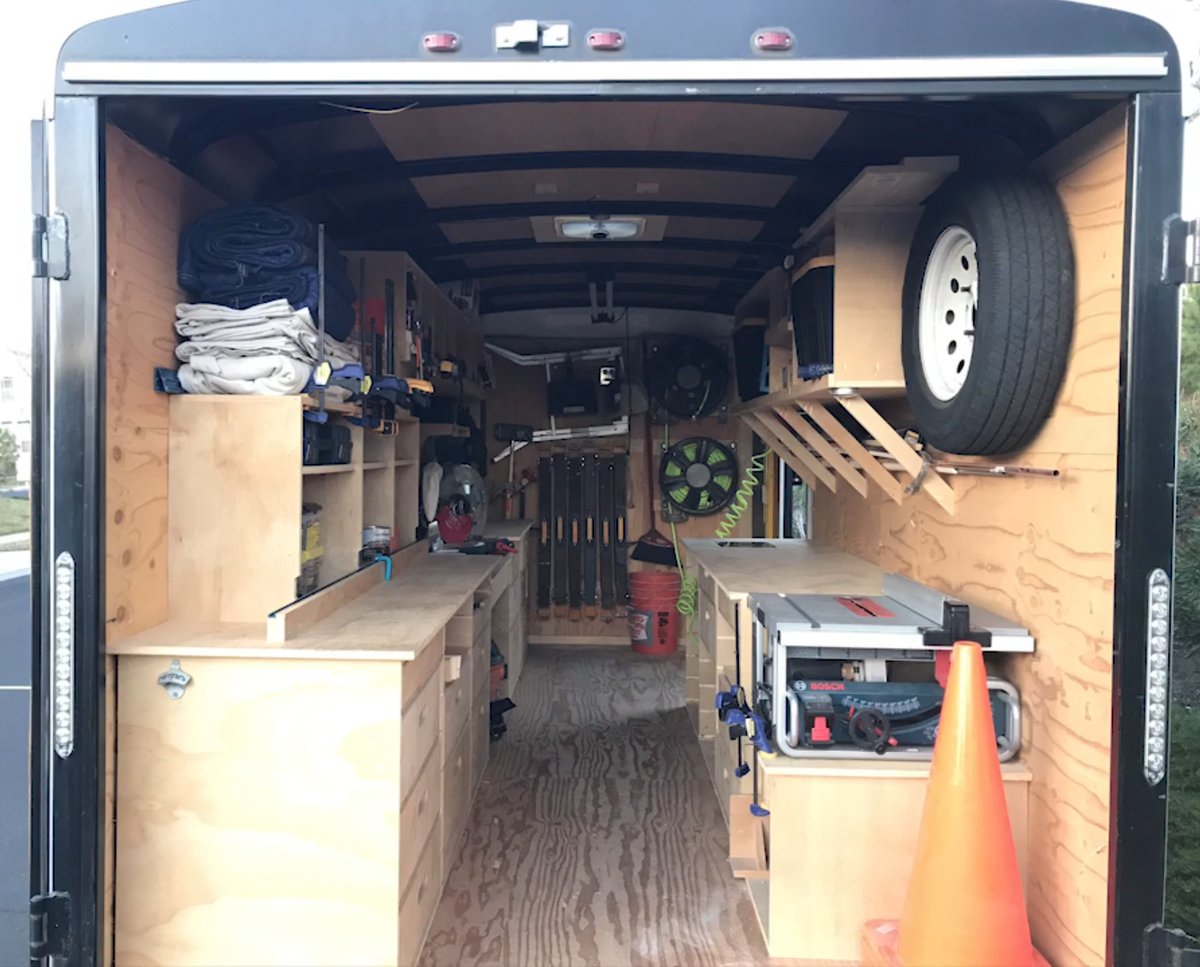
Using a lot of plywood in your build does two things:
- Takes up space
- Adds weight
You can reduce your use of plywood by making larger compartments, making fewer drawers, and using 5/8" instead of 3/4" plywood.
Think "shelves" instead of "drawers".
Drew's carpentry trailer and Asa's construction trailer have fewer drawers and more large compartments. Christian's remodeling trailer has lots of drawers and shelves and organization, but it weighs a lot!
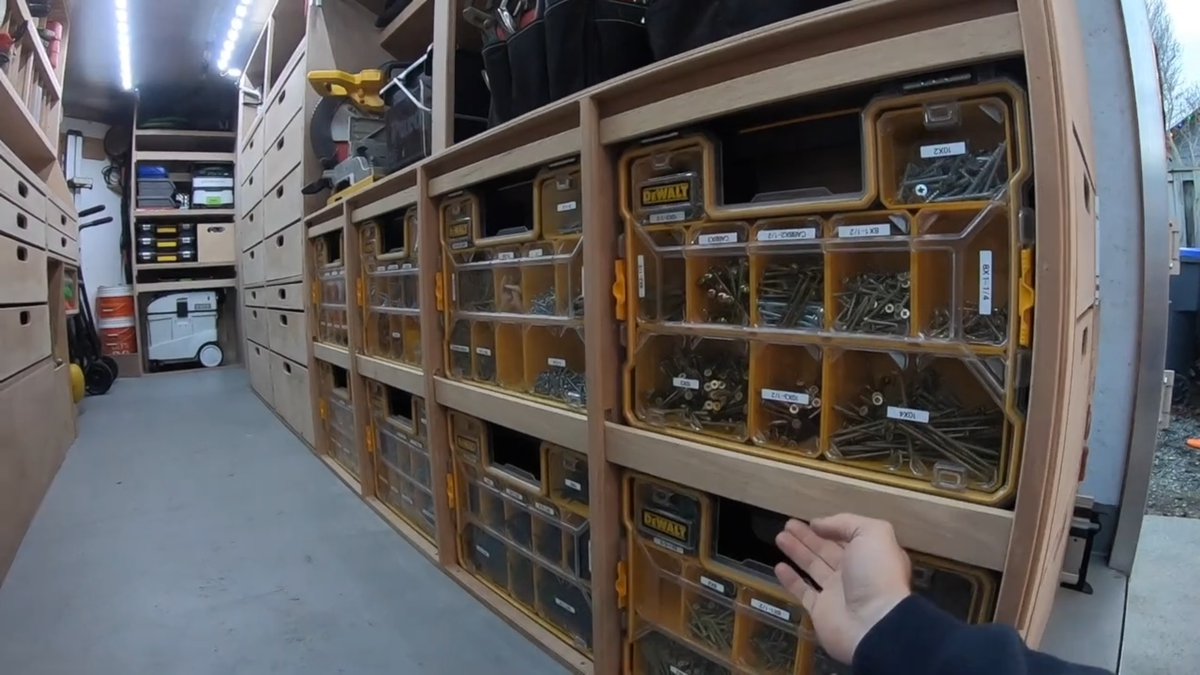
Watch Your Weight
Smaller tool trailers have lower weight ratings than big tool trailers.
If you're bumping up against your trailer's GVWR with your build, you won't have a lot of margin for throwing in sheets of plywood, stacks of lumber, or boxes of tile.
Also, pulling a heavy tool trailer can be a struggle for a smaller truck.
Use Plastic Bulk Bins

Plastic bins can be used to store tools, outlets/switches, screws/nails, pipe fittings, and whatever else you want.
They are lightweight, cheap, and easy to rearrange.
You can take a bin of hardware on the jobsite or put it on your workbench so that you don't need to bend over to pick stuff out.
Use a Wall-Mounted Toolbox System
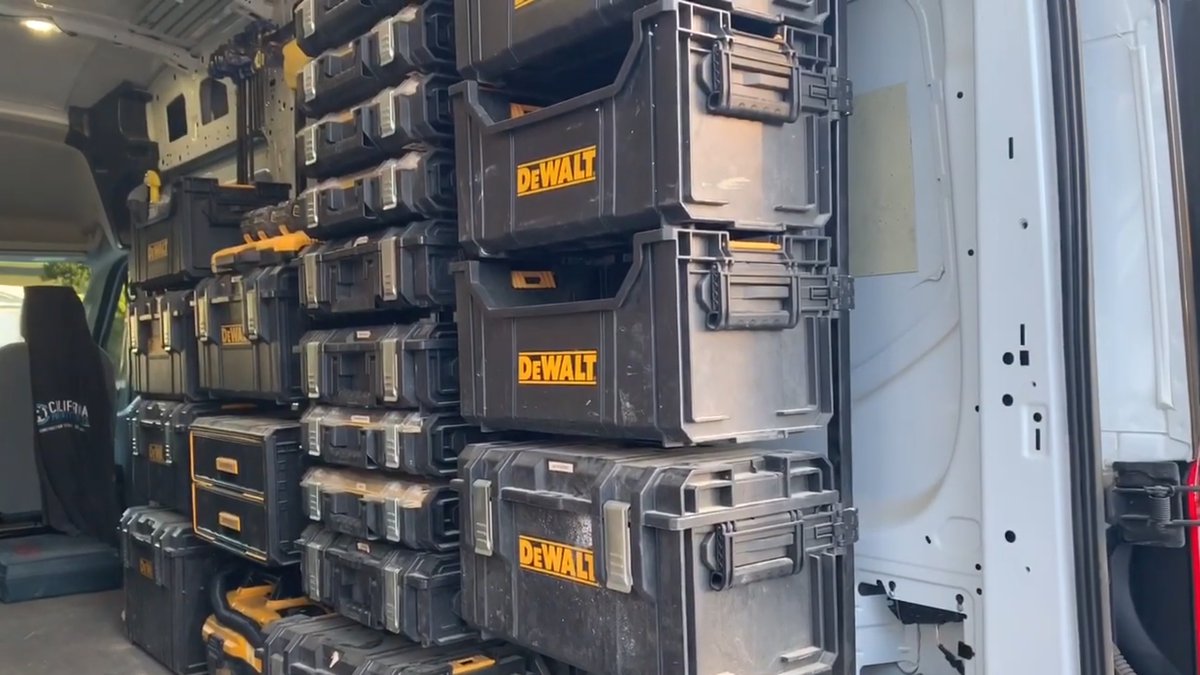
Several manufacturers make organizers and tool boxes that stack on carts, clip to your walls, and store collections of materials and tools.
Some tradespeople build plywood cubbies to hold these tool boxes and some mount them directly on the wall.
One benefit of wall-mounted organizers is that they can be removed if you need more cargo hauling space.
Or Use E-Track to Mount Storage


E-Track can be used to make part or all of your small tool trailer build removable.
Need more hauling space?
Detach your tools and storage and roll them out. Works best with a ramp door.
What's E-Track?
It's the stuff mounted on the walls of moving trucks and tractor trailers.
You can buy brackets for it for tying things down or for mounting 2x4s. This won't work as well if you plan to build plywood shelves and cabinets unless they're pretty modular.
You shouldn't go too crazy building complicated, modular storage. If it's too difficult to use, you won't use it.
Use Clever Combos of Organization
Your small tool trailer doesn't need to be:
- All Packouts
- All plywood shelves and drawers
- All E-Track
The purpose of your build isn't to "have a Packout trailer".
It's to be organized, fast, and efficient.
Pick and choose combos of organization so that you can make your tool trailer flexible and efficient.
You can do things like:
- Steel shelves on one side and a Packout wall on the other.
- One side of plywood drawers and one side of removable toolboxes on the other.
- Tool and material storage in the front, cargo hauling in the back.
You Don't Need All Your Tools on Every Job

You've probably got some specialty tools kicking around that you rarely need.
Leave them at "the shop" (your garage?) unless you need them.
Rarely used tools take up space and sometimes even need to be moved to access other tools. If you're shuffling tools, you're wasting your precious time.
Mark took this idea to the extreme because of theft: they empty the vans at night and re-kit in the morning for the jobs that need to be done that day.
Refill From Bulk Inventory at "the Shop"
Supply house runs are a time suck.
You should love buying bulk.
It makes sense because you need to make fewer runs to the supply house and you pay (a little) less.
So:
Buy your 30 sticks of PEX, your buckets of screws, and your spool of Romex.
Take what you need for the next week in the trailer and leave the rest at your shop.
Avoid the supply house.
Anyone from one-man electrician and carpentry shops to multi-employee HVAC companies do this.
Get work trucks and tips in your mailbox.
Your time is precious. We write about organization, tools, and techniques that make tradespeople work faster and more efficiently. Subscribe to get our articles and tips in your inbox.
We will not spam you.